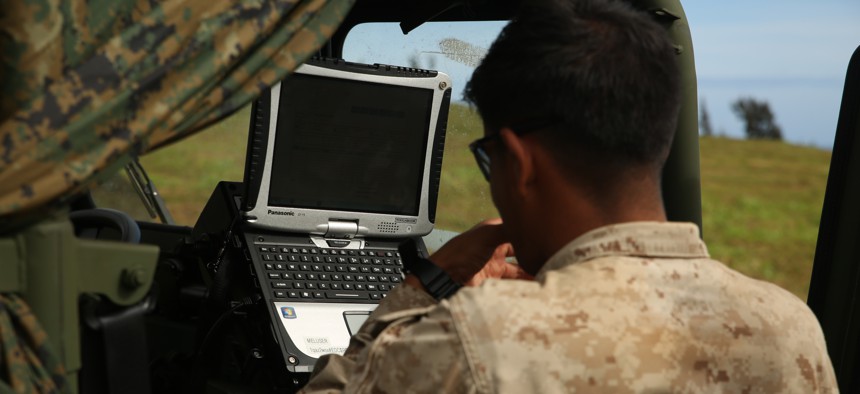
A Navy corpsman prepares the Tactical Tele-Medicine device for possible use during the Rim of the Pacific 2014 exercise. The device was being field tested by the Marine Corps Warfighting Lab. U.S. Marine Corps / Sgt. Sarah Dietz
Defense Business Brief: Getting new tech to troops faster; F-35 mission capable rates rise; Huge bonuses for vaxxed employees; and more.
Companies that unveil new technologies or weapons during military exercises should consider leaving those systems with troops after the demonstration. The recommendation of one way to get weapons to the battlefield faster came from Frank St. John, Lockheed Martin’s chief operating officer, during a presentation at a National Defense Industrial Association event this week.
“When we go do these demonstrations of a capability, something like Northern Edge or Project Convergence or things like that, I think we have to come to the realization that there's a real value in leaving behind that capability,” St. John said. “Unfortunately, a lot of times, what we do is we show up for two weeks, we demonstrate something really cool. And then we pack it up and take it home with us.”
This can frustrate combatant commanders who want the technology immediately, St. John said. If going through the traditional requirements, budgeting, and acquisition process, it could take a half decade to get the technology onto the battlefield.
“What we want to do looking forward is when we go into theater and do something like that, we want to find a way to leave behind copies of what we just demonstrated,” St. John said.
Leaving the technology beyond could “accelerate the requirements development process,” as well as “generate some enthusiasm” to help it get funding, he said.
One big question is how this would impact competition, particularly if another company is already making something similar?
Our friends at Defense News published their annual list of the Top 100 defense companies. Of note, Raytheon Technologies, formed by the combination of United Technologies and Raytheon, has jumped ahead of Boeing to the No. 2 position, behind Lockheed Martin, which stays in the top slot. General Dynamics fell from No. 3 to No. 5.
M&A recap. Two of note over the past few weeks: Huntington Ingalls Industries said it would buy Alion Science & Technology for $1.65 billion. And satellite imaging company Planet Labs said it plans to go pubic through a merger with a special purpose acquisition company. The deal is valued at $2.8 billion.
Leidos is offering employees a chance to win a bonus equal to their annual salary if they get a COVID-19 vaccine. It expects to pay out about $1 million in total prize money to 10 employees, the company said July 7. Leidos has about 35,000 employees in the United States.
Weekend reading: Two notable Government Accountability Office reports. First, the F-35 annual mission capable rate—“the percentage of time during which the aircraft can fly and perform one of its tasked missions”—rose from 59 to 60 percent between 2019 and 2020. But that news isn’t all good. The plane's full mission capable rate—“the percentage of time during which the aircraft can perform all of its tasked missions”—rose from 32 to 39 percent. That’s below the Air Force, Navy, and Marine Corps objectives. Air Force F-35As have a full mission capable rate of 54 percent, well below its 72 percent objective. More here.
Another report two looks at serious accidents involving Army and Marine Corps tactical vehicles. “Driver inattentiveness, lapses in supervision, and lack of training were among the most common causes of these accidents, according to GAO analysis of Army and Marine Corps data.” Read the rest here.
Making Moves
The White House said President Biden intends to nominate Gabe Camarillo to be Army undersecretary. Camarillo served in several Pentagon positions during the Obama administration. Biden nominated Alan Estevez, another Obama-era Pentagon official, to be commerce undersecretary for industry and security. Mike Brown, the head of the Pentagon’s Defense Innovation Unit, has withdrawn himself from consideration to be undersecretary for acquisition and sustainment due to an ongoing IG investigation.
SAIC has named David Norquist, former deputy defense secretary and Pentagon comptroller; Ellen Lord, former undersecretary for acquisition and sustainment; and Dana Desey, former CIO, to a new Strategic Advisory Board that will “provide advice and guidance to facilitate growth and innovation” at the company.
Space startup Momentous has named former Pentagon policy chief John Rood as its CEO.
 From Defense One
From Defense One
British Defense Secretary Vows to Fix Tank that Deafens Troops // Marcus Weisgerber
Wallace is to meet with the CEO of General Dynamics, maker of the Ajax light tank.
Biden Nominee for Pentagon's Top Weapons Buyer Withdraws // Tara Copp
Michael Brown to remain at DIU for now, Pentagon says.
Researchers Create Drone Swarms That Can Detect Gas Leaks, Other Threats // Patrick Tucker
A new algorithm called "Sniffy Bug" shows how tiny drones will do dangerous work even in areas where they can't use GPS.
Plywood Satellite Cleared for Space Launch // Tara Copp
The WISA Woodsat could reduce space debris by using materials that will burn as they fall back into Earth's atmosphere.
Army's New Facility Aims to Speed Up Fielding Tech // Brandi Vincent
Work there will support DOD's new soldier goggles — formally known as the Integrated Visual Augmentation System.
Impersonations of Military Members on Social Media On the Rise, New Report Says // Patrick Tucker
Be skeptical of that admiral who just asked you out on Twitter.
National Guard Scrambles for Funds After Congress Refuses to Cover Jan. 6-Related Costs // Tara Copp
More than a half billion dollars in the hole, the Guard's chief has ordered the heads of the Army and Air Guards to claw back money from state units.
How the Intelligence Community Can Get Better at Open Source Intel // Bob Ashley and Neil Wiley
Several factors make it harder to use publicly available information in all-source assessment than classified information.
